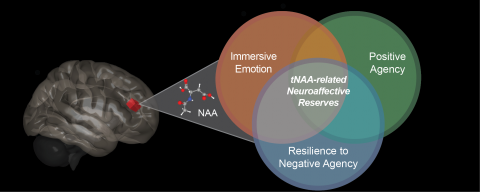Study delves into emotional wellness in the human brain

A new study is the first to reveal specific brain compounds that signal emotional wellness in healthy people.
Scientists at Brown University’s Carney Institute for Brain Science used proton magnetic spectroscopy (1H-MRS), a noninvasive brain imaging technique, to determine how specific biochemical compounds in the brain relate to daily emotions. The researchers focused on two emotions: agency, the ability to shape one’s world, and flexibility, the ability to fluidly respond to events as they unfold. The study is the first to identify that a compound in the brain called NAA plays a key role in agency and flexibility in healthy people.
The study was published on October 27 in NeuroImage, a journal that communicates advances in brain-behavior relationships that can be assessed by non-invasive imaging methods. The work was led by Tara White, assistant professor of behavioral and social sciences (research) at Brown, and her team at Brown, the University of Florida and the University of Calgary.
“Agency and flexibility are important aspects of everyday life,” said White, who is affiliated with the Carney Institute and the Center for Alcohol and Addiction Studies in Brown’s School of Public Health. “Our data provide insight on the brain mechanisms that support agency, immersive emotion and resilience to aggression in healthy people.”
NAA, which is found at high concentrations within neurons, is considered a marker of neuronal health. The researchers found that NAA was strongly related to three traits in healthy individuals: emotional fluidity, positive agency and non-aggression.
The NAA compound was evaluated within the dorsal anterior cingulate, a brain region involved in multiple networks of emotion, cognition and behavior. According to the study, individuals with a higher level of NAA reported more immersive and richer emotion in comparison to those with lower NAA, as well as a higher level of goal directedness, more positive emotion and less aggression. The researchers define the relationship of NAA with agency and flexibility in healthy people as a novel dimension termed “Neuroaffective Reserves.”
“These findings tell us how immersive emotion, positive agency and resilience to aggression work in the human brain,” White said. “These findings indicate NAA and other brain compounds play a fundamental role in emotional wellness and positive emotional outcomes in healthy individuals.”
The researchers also found that behavioral flexibility and engagement were moderately related to glutamatergic compounds involved in excitatory neurotransmission, learning, memory and goal-directed behavior, White said. Additionally, affiliative bonding was related to Choline, a precursor of the neurotransmitter acetylcholine, which is involved in emotional learning. These findings inform the brain foundations of positive emotion, engagement and interpersonal connection in healthy people.
“This imaging approach is interesting because these biochemical compounds could be used as an objective brain marker for traits related to wellness,” said Meghan Gonsalves, an author of the study and a Ph.D. student at Brown who holds both bachelor’s and master’s degrees from the University.
As a next step, White and her team will establish a three-pronged research program on brain metabolites that contribute to emotions in healthy adults. White received a Zimmerman Innovation Award last year from the Carney Institute to collect the preliminary data on this topic. The long-term goal, she said, is to build a research program on the neurobiology of human emotion at Brown.
The research was funded by the National Institute on Drug Abuse (DA R21 029189).



